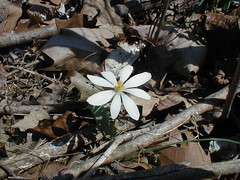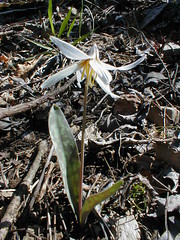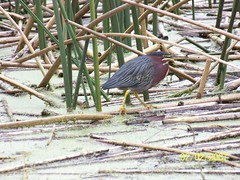Here's the unedited text of the article that will appear in the Flyer for Outdoor Recreation Month in Eureka
- - - - - - - - - - - - - - - - -
Birding opportunities around Eureka Springs
Copyright JP Valentik
The town of Eureka Springs, its parks, the lakes nearby, and several other places within fifty miles offer ample opportunity to see in excess of two hundred species through the course of the year. We have a good selection of year round residents typical of the Eastern Hardwood Biome, and our location between the Central and Mississippi Flyways guarantees an excellent selection of migrants, but not in extreme numbers. Our location is also near the eastern edge of the old Tallgrass Prairie. so an hour's drive can reach another whole realm of birding possibilities. The Ozarks are one of the largest tracts of somewhat intact hardwood forest in the country, and the
landscape is the oldest in North America that has neither been glaciated nor submerged by the ancient oceans. This has given ample time for a wide variety of plants and animals to evolve and adapt, creating many unique biological communities. Birds are too wide ranging for this process, but more sedentary critters like salamanders, fish, mussels, crayfish, even earthworms have developed a radiation of species.
Here's an overview of a widening circle of places to watch for various avian critters and spectacles. Within Eureka proper: Above all don't miss the Chimney Swifts circling and diving into the old chimneys of the downtown buildings. The best place to watch is from the wall extending from the public restrooms near the New Orleans Hotel downtown during the hour before sunset. Relaxing and fascinating. If you've never seen a Red-headed Woodpecker, Eureka is one of a few places in the south where they are resident. In most of the rest of
the state they may or may not show up in the winter. Best spots are on East Mountain in the first quarter mile downhill from Hiway 62, from the porch of Rosco's Coffeehouse across from Bubba's BBQ, and along Pivot Rock Rd. During spring the trilling of Pine Warblers
can be heard from almost any cluster of large pines in town. A very good spot is the Cemetery, which is also good for other pine specialists, like Yellow-throated Warbler, Pine Siskins (in winter) and some winters, Red-breasted Nuthatches. Some of the hollows
scattered around town can have a wonderful variety of birds singing at dawn and dusk, especially Wood Thrushes in the summer, which the locals call "eternity birds". In migration, the same spots have Swainson's Thrushes. I recommend the hollow extending uphill behind
the Grand Central Hotel, which can be walked in a convenient loop which is only steep at the beginning and end. The hollows below the Crescent Hotel, both sides, and across from the library are also good. And one shouldn't miss the often relocated roost of both Turkey
and Black Vultures (yes, there are two kinds, study the white patches on the wings), which can be seen over the town in large numbers almost any day.
The town also has two fine parks for general birding.
** Black Bass Lake located at the foot of Oil Springs Road on the left of Hiway 62 about a quarter mile west of the Inn of the Ozarks, This is an old park getting a lot of new attention. Plans are for it to be a node of an extended trail system stretching from the Town of Beaver
to Lake Leatherwood. You can walk around the lake, but it may be easier to go in and out on the old road. Make sure to check out the smaller pond about 75 yards above the head of the main lake. Approach carefully and you may get good looks at Wood Ducks. I haven't birded it much, but it is the only place I've seen a Snipe in Carroll County. There is a real critter called a snipe.
** Lake Leatherwood City Park located about a mile west of Eureka proper at the foot of the Leatherwood Curves. Go to the second entrance, not the ballfields. There's 1600 acres of mixed habitats in the park, including the 160 acre lake itself. I've documented just under 200 species over the course of ten plus years. That's more than half the species ever seen, even just once, in Arkansas. The area around the bath-house and cabins, with widely spaced mature trees, is excellent for passerine residents and migrants. The lake shines in fall and winter as a duck attractor, and during the spring and summer can be very good for herons, and a few shorebirds. At the inlet end of the lake is an area of mature bottomland hardwoods, which attracts migrant and breeding warblers and such. This is a reliable place for Blue-wing Warbler, Northern Parulas, Kentucky Warblers, Worm-eating Warblers, Chats, Acadian Flycatchers, several Vireos including Yellow-throated, and a general selection of woodland species. Large trees along the lakeshore attract several pairs of Orchard Orioles, and Eastern Kingbirds. The area of the bird-blind is very good for seeing these, as well as the Herons and Wood-Ducks. Note that Woodies are very shy, arriving early and quietly is the key to good views. Luck helps. Worth the effort since they are one of the most beautiful critters in North America. There are also numerous Cedar Thickets, which can be deserted or hosting foraging mixed flocks. Thrushes like them too. To get a more detailed knowledge of the park, attend one of the several public hikes put on locally or by Northwest Arkansas Audubon. Most Sunday mornings, pretty early, I'm doing a count and welcome company.
Striking out a little further afield, the area of Table Rock Lake near the Beaver Bridge, and at the Marina at Holiday Island can be good for Gulls and Terns, including the endangered Interior Least Tern. Go thru the village and up the hill to the Beaver Firehouse, park away from the firehouse doors, and walk around back. Across the Inlet below the cliff is a Blue Heron Rookery good for hours of entertainment during breeding. Keep children away from the cliff. About a mile past the Beaver firehouse on the left after coming back down to creek level is a small pond that has a pair of breeding Hooded Mergansers. Shy birds, so stay in your vehicle and be careful where you stop so that traffic from either direction can see you.
If you continue on 187 and then turn left (East, downhill) in about a half mile you come to the road to the Houseman access to the White River. Go down and check out the old cemetery, and search for Prothonotary Warblers which may breed along here. Returning to Hiway 62, continue East to the next 187 turnoff marked for Beaver Dam and the Dam-site Park. The Lake in winter is sometime good for deep water ducks, sometimes Loons too. But it's often disappointing. Better are the campgrounds below the dam, accessed by a turnoff on the left before you reach the actual dam. Sometimes somebody is collecting an entry fee for the Corps of Engineers. The campgrounds are good places for Ovenbirds, which seem very tame down there, walking through the campsites. The patch of cane at the end of the road is often good for Swainson's Warbler, but be prepared to work for it. Best during breeding, so playbacks not advised then, and they abandon their territories after fledging, so the window is narrow. They can also be found at Lake Leatherwood, with luck of course.
On the East side of town after checking the Cemetery, continue to the left turn toward Grandview after the King's River Bridge. After passing through the old town you come to open farmland that is remnants of the original tallgrass prairie. You can find Shrikes here, but the prize is flocks of Bobolinks in spring migration. The King's River itself can make a pleasant day of birding from a canoe, and there are several outfitters who will rent the necessities and provide a shuttle. Check the phone-book.
Three more sites are worth mentioning. Roaring River State Park (has camping and a nature center) just over the border in Missouri is an excellent place during migration, and pretty good the rest of the year. Withrow Springs State Park, about 25 miles south on Hiway 23 has a wonderful trail along the War Eagle River, and you can camp there too. If you desire shorebirds at the appropriate time of year, the best site is about an hour's drive west at the Charlie Craig Fish Hatchery in Centerton. Here's a little more detail.
** Roaring River SP, located between Cassville and Eagle Rock, MO, reached by going north on Hiway 23, then west on MO 86. Watch for signs. There are several places in the park that have good birding. The campground itself is usually good, as well as the informal trails you can poke around on at the upper end of the campground along the river. The best spot though is to walk up the dirt road that heads uphill from the hatchery. This is a good place for finding Cerulean Warblers, not guaranteed, but you'll find a lot of other species regardless. Check in at the nature center for the most current information.
** Withrow Springs SP. Drive down 23 south until you come to the park entrance road in Forum. Drive through the park, stopping if you get an inspiration, but the focus of the trip is at the far end of the park. You'll come back to Hiway 23, go right and then very soon, just before the bridge go right again into a perking area. The trail goes to the left under the highway and then along the War Eagle River passing some great habitat. The trail is slightly elevated from the floodplain, giving an excellent viewpoint. of canebrakes as well as more open bottomland habitat.
** Centerton Fish Hatchery is just south of the main intersection in old Centerton. If the big gates are closed there's a pedestrian gate, but its okay to gently drive the levees around the various pools. Look for drained pools with mudflats, which are what attracts the shore birds. Best times are northbound from mid-April to early June, and southbound from late July to October. Numbers aren't as good as major flyway stopovers, but the variety through time is quite satisfying. Also watch for Scoters in winter, Black Terns in spring, and Yellow-headed Blackbirds in spring and summer. Unusual Hawks can show up as well, drifting in from the Prairies to the west.
Resources
The Eureka Nature Blog
http://natureofeureka.blogspot.com/ has reports of local natural history events, announcements, and simple rant.
The Archives of the ARbird listserv
http://listserv.uark.edu/archives/arbird-l.html this has postings from birders from all over the state concerning sightings and commentary on issues. If you like the material you can sign up for free. Follow the instructions.
The Arkansas bird checklist
http://www.arbirds.org/ go down the page to downloads. There are some other good ones too, especially the butterfly checklist. On the bird checklist is a tremendous amount of information in very condensed form. All the species ever seen in the state are listed, and codes provide the usual times of year, parts of the state, and abundance. It's a PDF, so you can print a copy, or order nice printed ones.





